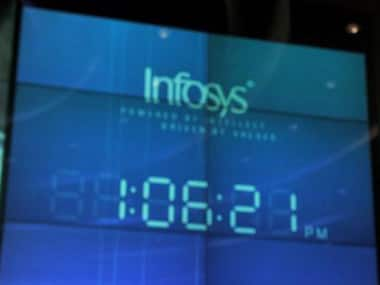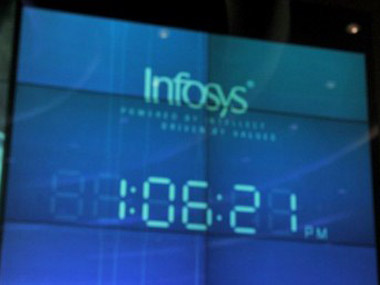As Infosys continues to disappoint the markets, the question on everybody’s lips is the same: why is this former darling of the bourses taking so long to get its act together?
The answer is probably very simple: it has been afflicted by high-marginitis. This is a disease easily contracted by companies which have gotten used to such high margins in the past that to stoop lower for volumes sounds like blasphemy to them.
[caption id=“attachment_489522” align=“alignleft” width=“380”]
 Hope on Infosys. AFP[/caption]
Hope on Infosys. AFP[/caption]
In an interview with The Economic Times, outgoing CFO V Balakrishnan, Infosys’ high-margin strategist and a possible future CEO, gives us a peek into the company’s thinking. He says “we are not saying no to commodity business” but “incrementally we want to do high-value businesses.”
In short, Infosys wants to reduce the proportion of its low-value application development business, where it often has to compete on price with rivals. It is dragging its feet on this score.
Balakrishnan also had this to say when asked whether competitors should worry that Infosys may start to play the price game: “They should have the fear, because we give the pricing cover for all of them….We are giving them (price competitors) the umbrella. Else, they would have to get drenched.”
It is a costly umbrella to hold.
What Bala is trying to say is this: Infosys’ high pricing creates a market for price rivals, but it does not mean Infosys will not place the price game itself when required. But the preferred route is to keep moving up the value chain through products, platforms and consulting.
Impact Shorts
More ShortsThis can be diagnosed as a case of high-marginitis.
While the strategy to keep moving into high-end areas makes absolute business sense, Infosys is at the same crossroads that once confronted companies of the stature of Hindustan Unilever, Britannia and many others.
Hindustan Unilever (then Hindustan Lever) was the king of the high-end detergents and toiletries business in the 1980s when Karsanbhai Patel and many others suddenly opened up the low-margin, high-volume mass segment of the market. Patel’s Nirma, and other rivals like Ghari detergents, began growing so fast that Hindustan Lever was in danger of being reduced to a niche player - even if it was horrendously profitable.
The same thing happened when Prakash Chauhan’s Parle-G raided the lower-end glucose biscuits market, and Britannia adopted a superior attitude and avoided a price war as long as it could. The only result was a complete takeover of the volume business by Parle-G. It took Britannia almost a decade or more to respond with its own value packs and the Tiger brand, among other initiatives.
The strategic choice is simple: once can remain wedded to the high-margin business, since that will always be profitable. But does a big company have the option of not getting into the price game if it wants to stay big?
The stories of Hindustan Unilever and Britannia suggest that high-margin companies cannot let interlopers gain control of the volume end of the business since that can soon start taking away the high-margin business as well.
Consider what would have happened if Hindustan Lever had not launched Wheel to take on Nirma. As Nirma took the volumes, shopkeepers and retailers would have given it more shelf space, and in due course the visibility of Nirma would have been greater than Surf. Even though Surf would have been the choice of the classes, without a Wheel there was no chance of graduating low-value customers to move up the value chain. Surf would have become a brand for indulgence, not utility. A stronger Nirma would then have been ideally placed to take on the upper end of the market too. Surf, too, would have been history.
The same would have been the case of Britannia. Without a blockbuster entry into the low-margin business, it would have lost control of the upper-end too in due course.
One should consider Infosys’ own success story. It gained traction in the US and North America because in those markets it was the low-margin rival to the IBMs, Accentures and EDSs of the world. Infosys forced these global majors to get into the lower-margin businesses by setting up software development centres in India.
Infosys clearly needs to abandon its high-margin obsession and opt for volumes, even while continuing to acquire companies in the consulting space - as it did recently with the Lodestone acquisition in Europe for $350 million.
To be sure, analysts have criticised Infosys’ conservatism in acquisitions, but here it is surely right. The world over, two-thirds of acquisitions driven by merely size have failed to deliver shareholder value, and going slow in acquisitions is not a bad strategy to adopt. But one can’t be sure its conservatism at the price-volume end of the game is right. With over Rs 22,570 crore in cash, the company can afford a few risks on the pricing front.
The Infosys 3.0 strategy needs wholehearted support for both prongs - high-margin and low-margin - if it is to get into the act faster.
High-marginitis means leaving the field open to rivals. It cannot vacate future space to nimble rivals who can then take the entire game away from Infosys.
(Disclosure: The author holds some shares of Infosys as part of his long-term portfolio)
)